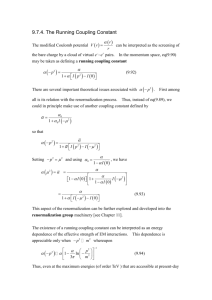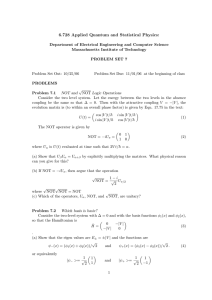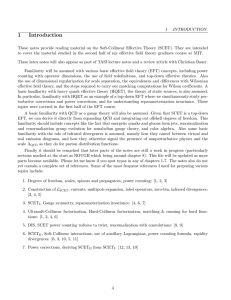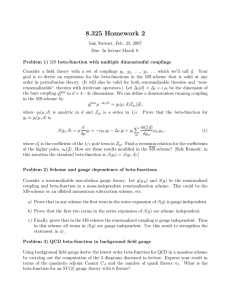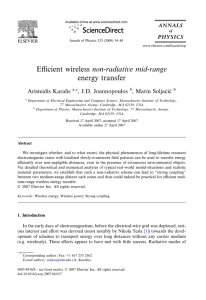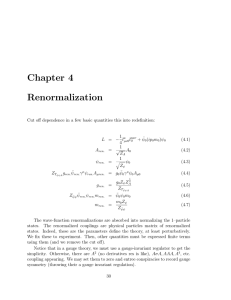Document 13470506
advertisement
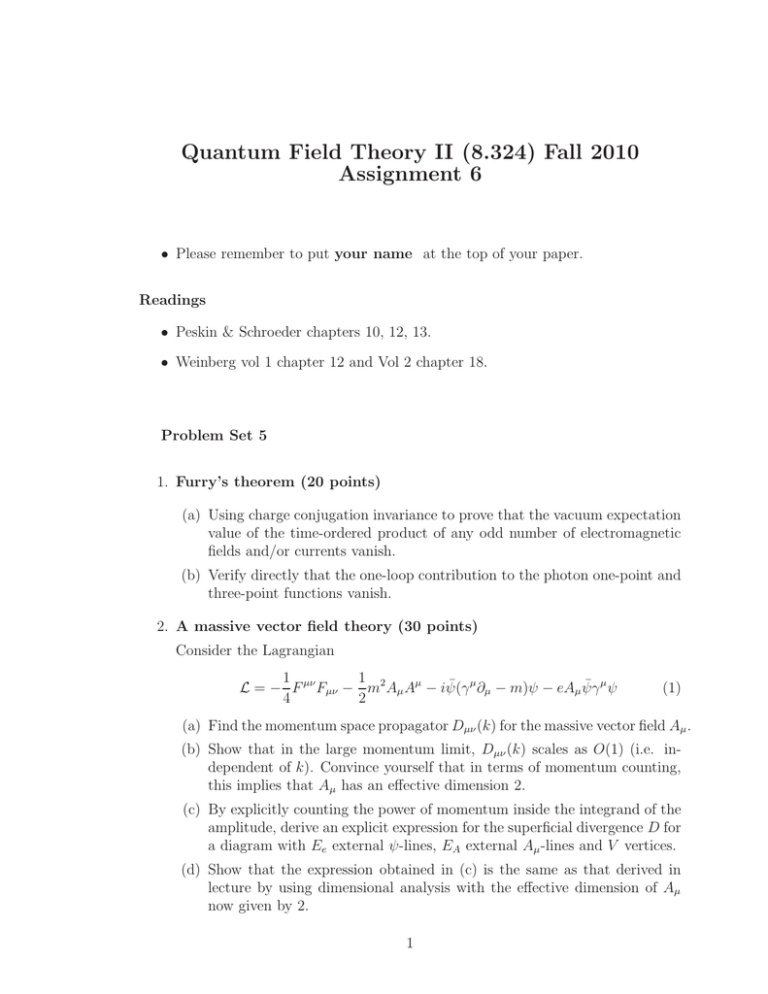
Quantum Field Theory II (8.324) Fall 2010 Assignment 6 • Please remember to put your name at the top of your paper. Readings • Peskin & Schroeder chapters 10, 12, 13. • Weinberg vol 1 chapter 12 and Vol 2 chapter 18. Problem Set 5 1. Furry’s theorem (20 points) (a) Using charge conjugation invariance to prove that the vacuum expectation value of the time-ordered product of any odd number of electromagnetic fields and/or currents vanish. (b) Verify directly that the one-loop contribution to the photon one-point and three-point functions vanish. 2. A massive vector field theory (30 points) Consider the Lagrangian 1 1 ¯ µψ L = − F µν Fµν − m2 Aµ Aµ − iψ̄(γ µ ∂µ − m)ψ − eAµ ψγ 4 2 (1) (a) Find the momentum space propagator Dµν (k) for the massive vector field Aµ . (b) Show that in the large momentum limit, Dµν (k) scales as O(1) (i.e. in­ dependent of k). Convince yourself that in terms of momentum counting, this implies that Aµ has an effective dimension 2. (c) By explicitly counting the power of momentum inside the integrand of the amplitude, derive an explicit expression for the superficial divergence D for a diagram with Ee external ψ-lines, EA external Aµ -lines and V vertices. (d) Show that the expression obtained in (c) is the same as that derived in lecture by using dimensional analysis with the effective dimension of Aµ now given by 2. 1 (e) Is this theory renormalizable? Why? 3. Operator product expansions (20 points) Consider a free scalar field theory in Euclidean signature with a Lagrangian � � � 1 L= d4 x (∂φ)2 + m2 φ2 (2) 2 (a) Express the operator φ4 (x) in terms of normal-ordered operators. (b) Denote O(x) =: φ4 (x) : where :: stands for normal ordering. Consider the operator product expansion (as |x| → 0) � O(x)O(0) = Cn (x) On (0) (3) n where On denotes a complete set of normal-ordered local operators built from φ and its derivatives. Work out the coefficients Cn (x) for those On who canonical dimension Δn ≤ 4. 4. Renormalization group properties (30 points) (a) Consider a coupling constant λ and a redefined coupling constant λ̄(λ). Find the general transformation law for the beta function, namely the relation between β(λ) and β(λ). If we think of λ as a coordinate we see that β transforms as a tensor. What kind of tensor ? (b) Assume that β(λ) = b2 λ2 + b3 λ3 + b4 λ4 + · · · and consider the perturbatively defined and invertible coupling constant redefinition: λ̄(λ) = λ + a2 λ2 + a3 λ3 + · · · . Calculate β̄(λ̄) writing it in the form β̄(λ̄) = b̄2 λ̄2 + b̄3 λ̄3 + b̄4 λ̄4 + · · · Verify that: i. b2 = b2 and b3 = b3 . ii. It is possible to make ¯ b4 anything you want by such a coupling redefi­ nition. iii. Let λ = λF denote a fixed point. Show that λ̄ = λ̄F is also a fixed point. How are the derivatives β ′ and β̄ ′ related at the fixed point? 2 (c) Consider the differential equation for a massless coupling g µ dg = −bg 2 − cg 3 − dg 4 − · · · dµ (4) with b, c, d numerical constants. Show that one can write a solution to the above equation in the form ln 1 c µ = + 2 ln bg(µ) + O(g(µ)) Λ bg(µ) b (5) where Λ is an integration constant, which can be considered as a dynami­ cally generated scale. Argue that Λ is renormalization group invariant. (d) More generally, show that in a renormalizable theory with a dimensionless coupling constant g(µ) and no other dimensional parameter (like in a nonAbelian gauge theory), dimensional transmutation happens. That is, show that g(µ) can be written in a form � � µ �� g(µ) = f log (6) Λ with Λ a universal scale and f a function depending on the specific theory. (Inverting (5) gives a specific example of f .) 3 MIT OpenCourseWare http://ocw.mit.edu 8.324 Relativistic Quantum Field Theory II Fall 2010 For information about citing these materials or our Terms of Use, visit: http://ocw.mit.edu/terms.

